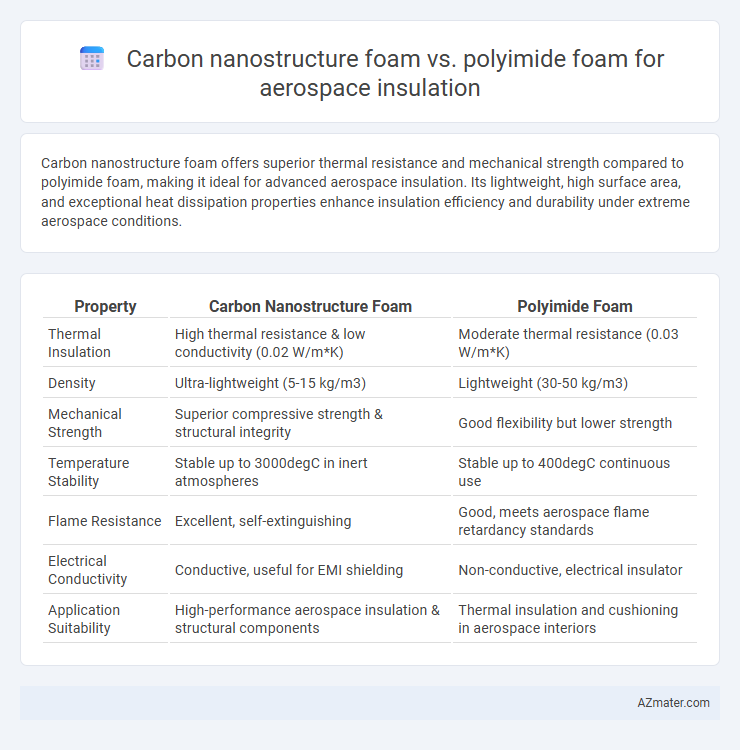Carbon nanostructure foam offers superior thermal resistance and mechanical strength compared to polyimide foam, making it ideal for advanced aerospace insulation. Its lightweight, high surface area, and exceptional heat dissipation properties enhance insulation efficiency and durability under extreme aerospace conditions.
Table of Comparison
| Property | Carbon Nanostructure Foam | Polyimide Foam |
|---|---|---|
| Thermal Insulation | High thermal resistance & low conductivity (0.02 W/m*K) | Moderate thermal resistance (0.03 W/m*K) |
| Density | Ultra-lightweight (5-15 kg/m3) | Lightweight (30-50 kg/m3) |
| Mechanical Strength | Superior compressive strength & structural integrity | Good flexibility but lower strength |
| Temperature Stability | Stable up to 3000degC in inert atmospheres | Stable up to 400degC continuous use |
| Flame Resistance | Excellent, self-extinguishing | Good, meets aerospace flame retardancy standards |
| Electrical Conductivity | Conductive, useful for EMI shielding | Non-conductive, electrical insulator |
| Application Suitability | High-performance aerospace insulation & structural components | Thermal insulation and cushioning in aerospace interiors |
Introduction to Advanced Aerospace Insulation Materials
Carbon nanostructure foam exhibits exceptional thermal stability and high mechanical strength, making it ideal for advanced aerospace insulation applications where temperature extremes and structural integrity are critical. Polyimide foam, known for its low density and excellent dielectric properties, provides lightweight insulation but may lack the superior thermal performance essential for next-generation spacecraft and high-speed aircraft. The integration of carbon nanostructure foam offers enhanced thermal conductivity control and superior resilience, advancing the development of innovative thermal protection systems in aerospace environments.
Overview of Carbon Nanostructure Foam
Carbon nanostructure foam exhibits exceptional thermal insulation properties combined with high mechanical strength and ultra-low density, making it ideal for aerospace applications. Its unique porous architecture and excellent thermal management capabilities outperform traditional materials like polyimide foam, ensuring enhanced heat resistance and energy efficiency. The foam's superior electrical conductivity and stability under extreme conditions further contribute to its suitability for advanced spacecraft insulation systems.
Polyimide Foam: Properties and Applications
Polyimide foam exhibits exceptional thermal stability, low density, and excellent flame retardancy, making it a superior choice for aerospace insulation compared to carbon nanostructure foam. Its high temperature resistance up to 400degC and low thermal conductivity enable efficient insulation in extreme aerospace environments. Commonly used in spacecraft and aircraft, polyimide foam offers lightweight protection against thermal shock, vibration, and acoustic noise, enhancing overall system performance and safety.
Thermal Insulation Performance Comparison
Carbon nanostructure foam demonstrates superior thermal insulation performance compared to polyimide foam, exhibiting lower thermal conductivity values typically in the range of 0.02 to 0.05 W/m*K. Its porous nanostructure effectively reduces heat transfer by conduction, convection, and radiation, making it highly suitable for aerospace thermal management under extreme temperature conditions. Polyimide foam, while lightweight and flame resistant, generally shows higher thermal conductivity (~0.03 to 0.08 W/m*K), resulting in less efficient insulation performance in high-temperature aerospace applications.
Weight and Density Considerations
Carbon nanostructure foam exhibits significantly lower density, typically around 0.1 g/cm3, compared to polyimide foam which ranges between 0.2 to 0.3 g/cm3, offering aerospace applications a substantial weight reduction advantage. The ultralight nature of carbon nanostructure foam enables enhanced fuel efficiency and payload capacity in aircraft and spacecraft by minimizing structural mass without compromising insulation performance. Its superior strength-to-weight ratio also allows for thinner insulation layers, further optimizing overall system weight in aerospace thermal management solutions.
Fire Resistance and Thermal Stability
Carbon nanostructure foam exhibits superior fire resistance and thermal stability compared to polyimide foam, making it highly suitable for aerospace insulation applications where extreme temperature endurance is critical. Its carbon-based composition provides enhanced char formation and minimal smoke toxicity under high heat exposure, outperforming polyimide foam, which tends to degrade at elevated temperatures. Additionally, carbon nanostructure foam maintains structural integrity and thermal insulation efficiency beyond 1000degC, surpassing the typical thermal limits of polyimide foams used in aerospace environments.
Mechanical Strength and Durability
Carbon nanostructure foam demonstrates superior mechanical strength compared to polyimide foam, with higher tensile strength and enhanced impact resistance critical for aerospace insulation applications. Its robust nanostructured matrix offers exceptional durability under extreme thermal cycling and mechanical stress, outperforming polyimide foam's tendency to degrade over time. The lightweight nature combined with sustained mechanical integrity makes carbon nanostructure foam a preferred choice for long-lasting, high-performance aerospace insulation materials.
Environmental Sustainability and Recyclability
Carbon nanostructure foam offers superior environmental sustainability in aerospace insulation due to its lightweight nature, enhanced thermal performance, and longer lifespan, reducing material consumption and waste. Polyimide foam, while effective in insulation, often involves complex chemical synthesis and limited recyclability, posing challenges for eco-friendly disposal and material recovery. Advances in carbon nanostructure foam recycling processes enable better material reuse and lower environmental impact compared to conventional polyimide foam solutions.
Cost-Effectiveness and Manufacturing Scalability
Carbon nanostructure foam offers superior thermal insulation and mechanical strength compared to polyimide foam, but its high production costs and complex synthesis limit cost-effectiveness and large-scale manufacturing scalability. Polyimide foam, while providing moderate thermal performance, benefits from established, low-cost manufacturing processes and proven scalability in aerospace insulation applications. The choice between these materials hinges on balancing advanced performance requirements against budget constraints and production capacity in aerospace projects.
Future Trends in Aerospace Insulation Technologies
Carbon nanostructure foam offers superior thermal conductivity and lightweight properties compared to traditional polyimide foam, making it a promising material for next-generation aerospace insulation. Advances in nanotechnology enable enhanced thermal management and structural integrity, critical for extreme aerospace environments. Ongoing research aims to optimize scalability and cost-efficiency, positioning carbon nanostructure foams as a transformative solution in future aerospace insulation systems.

Infographic: Carbon nanostructure foam vs Polyimide foam for Aerospace insulation
 azmater.com
azmater.com